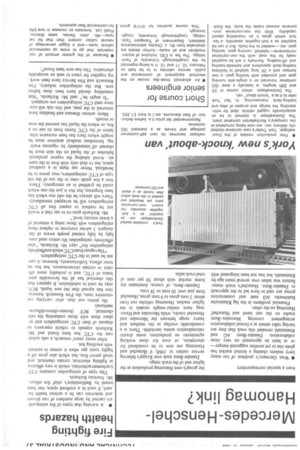Fire fighting health hazards
Page 39

If you've noticed an error in this article please click here to report it so we can fix it.
• A warning that types of fire extinguish ers carried by large numbers of van drivers and motorists can be a serious health hazard, if used in a confined space. has been issued by Bedfordshire's ,chief fire officer, Mr. Norman Richards.
This type of extinguisher contains CTC (carbontetrachloride), which is very effective in fighting electrical, certain chemical, and small petrol fires, but which also gives off a highly toxic gas when it comes in contact with anything hot.
After many years' research, a safe substitute for CTC has been found and Mr. Richards appeals to vehicle operators to dispose of their CTC extinguishers and replace them with those containing the safe .chemical, BCE (bromo-chloro-difluoromethane).
He points out that, after carrying out extensive tests, the Firs Research Associa tion has agreed that the new liquid, BC F. may be used in substitution. It appears that this chemical has all the favourable attributes of CTC, and is probably more efficient in certain circumstances, but has no toxic effects. Unfortunately, however, it cannot be used in the CTC extinguishers.
"The vapou r from CTC which soeffectively extinguishes fire" says Mr. Richards, "also effectively extinguishes life unless used carefully by fully trained people aware of the dangers. I advise everyone to replace these extinguishers with those using a material of a lower toxicity level."
Mr. Richards goes on to say that it would not be realistic to expect that all CTC extinguishers will be scrapped immediately. There will always be the odd one which has been forgotten, but this is just the one which could be grabbed in an emergency. Therefore a few guide rules in the use of the old type of CTC extinguishers, may prove to be beneficial. Never use them in a confined space, but to deal only with fires in the open air. Avoid inhaling the vapour produced. Splashes of the liquid on the skin must be cleaned off immediately by vigorous washing. Immediate medical attention must be sought where there has been excessive inhalation of the CTC fumes from its use on a fire, or where the liquid has entered the nose or mouth.
Many serious illnesses and fatalities have occurred in the past, and this risk will continue until CTC extinguishers are scrapped.
"It might be," said Mr. Richards, "that something should have been done before now. But the extinguisher industry, Fire Research and Fire Service have been working together for years to seek an acceptable alternative. This has now been found".








































































































